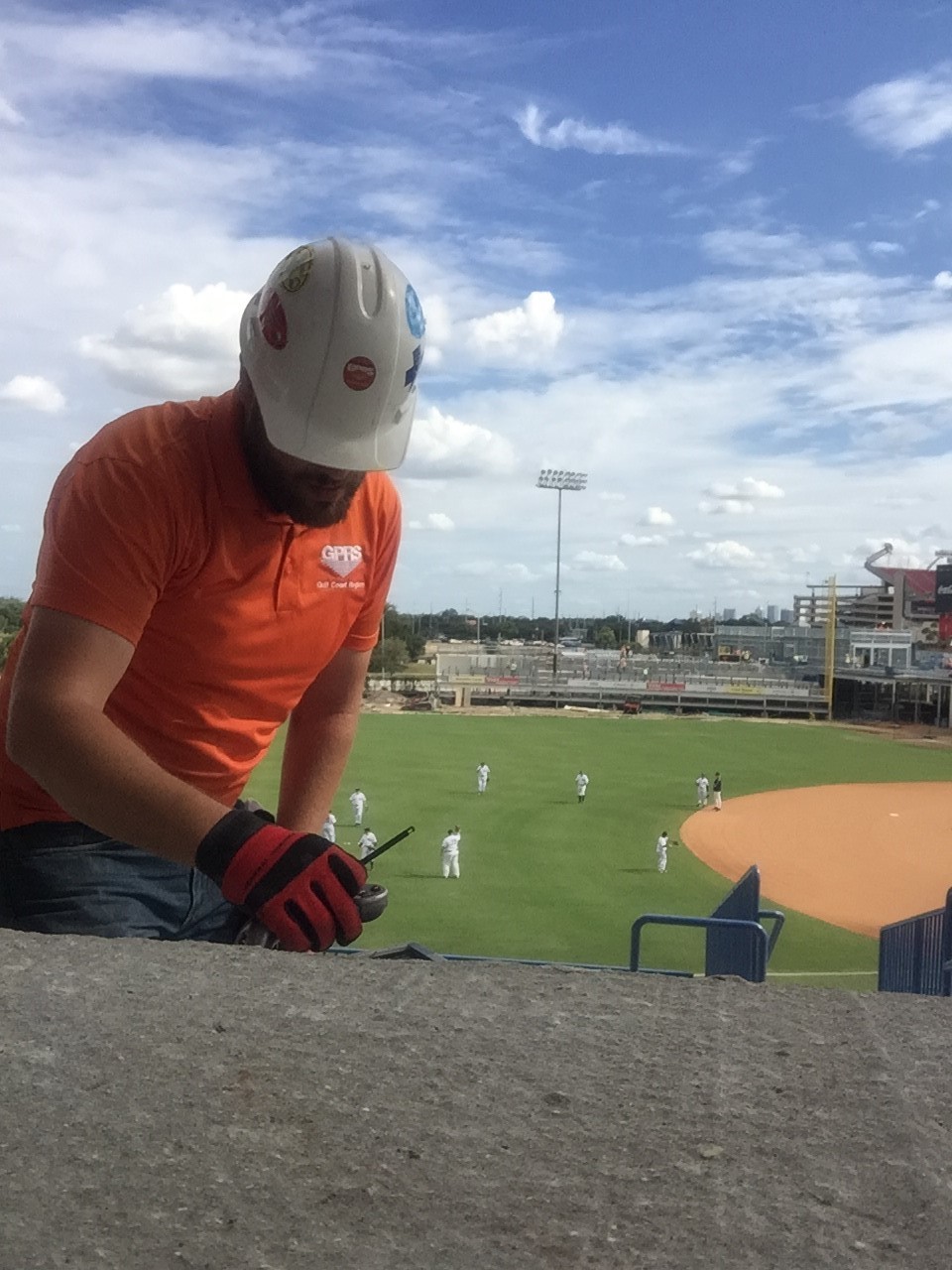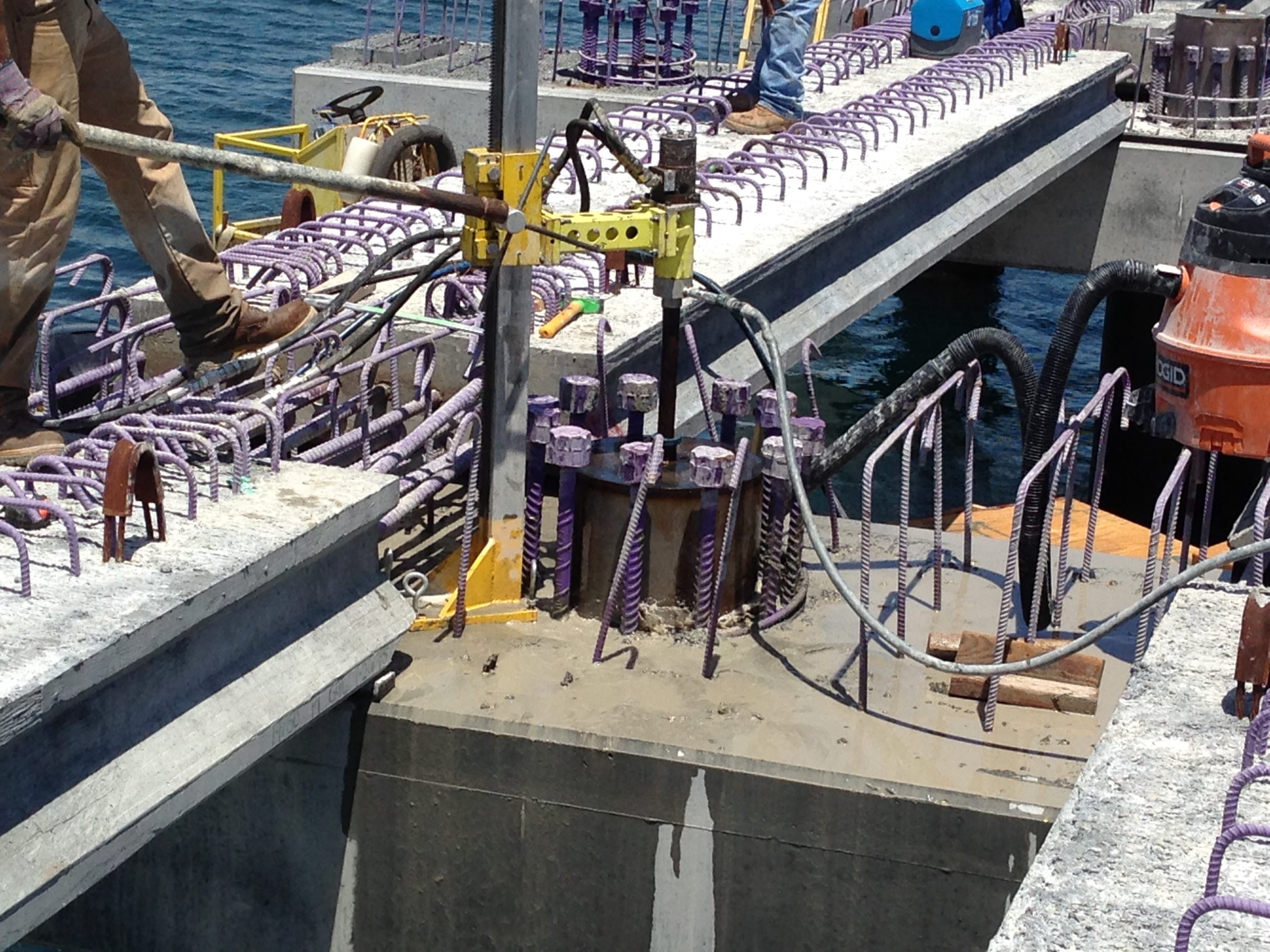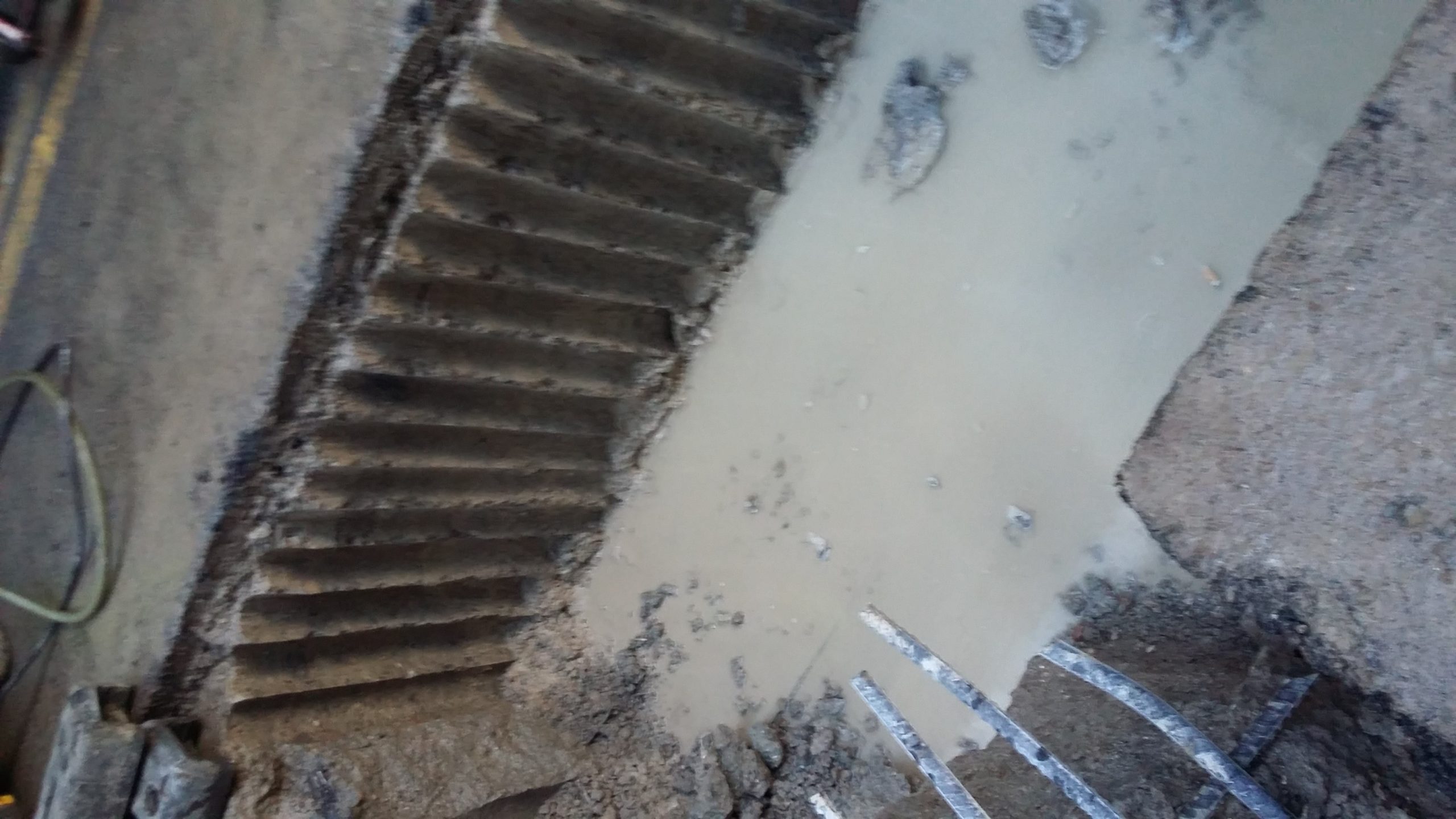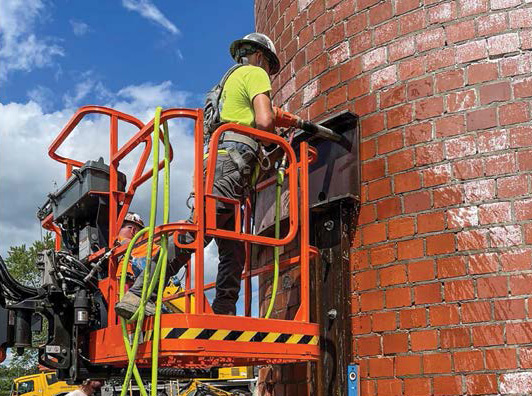
Dam these boys are Good
The Port of Pittsburgh’s Inland Waterways Navigation System consists of 17 locks and dams on the three major rivers that connect in Pittsburgh—the Allegheny, Monongahela and Ohio. Much of the infrastructure in the waterway system is 70 to 80 years old and desperately in need of repair. Due to its age and lack of consistent maintenance and upgrades, this lock and dam system, essential to shipping and recreation in the area, has deteriorated to the point that watercraft lockages have become severely impeded.

CSDA member Concrete Cutting Systems of Pittsburgh (CCS) was contracted to remove:
• A vertical concrete wall inside the lock chamber measuring 360 feet long by 22 feet tall and 12 inches thick
• Vertical concrete wall 330 feet long, 6 feet tall and 12 inches thick to make way for new steel grating above mechanical access points
• Ladder and line hooks along a vertical concrete wall inside the lock chamber measuring 13.5 feet long by 22 feet tall and 2.5 feet thick
A Challenging Work Schedule
The USACE allowed work within the lock chamber on a 3-2-5-2 schedule: three weeks full chamber closure, two weeks restricted chamber width to pass navigation, five weeks full chamber closure and two weeks restricted chamber width. CCS was to complete all face wall demo during the first three-week shutdown so the GC could install new precast panels during the five-week full chamber closure. Only having three weeks to complete the demo posed a big challenge.
Before the first shutdown, CCS spent 30 days line-drilling 130 2-inch diameter vertical holes to a depth of 22 feet. CCS employed three Hilti DD350 core drills for this phase of the job, drilling an average of six holes per 10-hour shift, 22 shifts total. Core drilling vertical line holes enabled the excavator mill head to know its depth when milling the face wall of the chamber.
During the first shutdown, work on the ladder and line hook area was to commence. The area to be demolished was 13.5 feet long, 22 feet tall and 2.5 feet thick and could not be reached by the mill. CCS employed a Hilti DSW 3018E wire saw to cut the ladder and line hook area into four 28,000-pound pieces. Wire sawing the ladder and line hook section into pieces was the only way to remove this concrete.
First, two 2-inch diameter vertical holes were drilled 22 feet deep, followed by 12 6.5-inch diameter horizontal holes. The wire cuts consisted of four 13.5 feet by 2.5 feet deep horizontal push wire saw cuts, two 22- by 2.5-foot deep vertical pull wire saw cuts, finishing with a 22- by 13.5-foot deep vertical pull wire saw cut.
The mill also could not reach the face wall in front of the metal pump house building, which was 23 feet long, 22 feet tall and 12 inches thick. This concrete was substantially deteriorated and wasn’t strong enough to be lifted out in pieces with a crane. CCS determined the safest way to remove the face wall was to cut it into one piece with the Hilti DSW 3018E wire saw and then hammer it with a Husqvarna DXR Demolition Robot from a barge as the back cut was pulled up.
To make this cut, two 22-foot vertical wall saw cuts 12 inches deep were made, followed by a 23-foot horizontal cut. Then, a 23-foot by 22-foot vertical pull wire saw cut was made to finish.
Elsewhere, wall saw cuts were needed on the face wall at the limits of work to provide a neat line and clear limit of demo for all work. CCS used Husqvarna HF482 wall saws to saw a 360-foot horizontal cut for neat line at the bottom of the chamber wall removal limits and two 22-foot vertical cuts for neat line at the limits of work. At the top of the wall they slab-sawed 700 feet of 15-inch thick concrete for the work limits. Slab sawing was the only logical solution to make this cut, providing the limits of work on the top of the wall demo.
At the gate recess area, the mill and crane couldn’t reach the vertical concrete wall, which was 34 feet long, 22 feet tall and 12 inches thick. In order to demo this area, CCS used a Husqvarna HF482 wall saw to cut 22-foot vertical cuts 12-inches deep every 13 inches. Then they used a Husqvarna DXR secured to a barge to hammer the sections into manageable pieces. A JLG lift was used to perform the wall sawing.

Two concrete walls between steel wall armor posed a unique challenge. The USACE wanted to save and protect the armor, so a big excavator was not an option. Time was short and hand tools could not complete the demo on time. The only option was to use a Husqvarna DXR chained to a barge to hammer the sections, which were 15- by 22-feet tall and up to 12 inches deep. The mill head also could not reach the bottom two feet of a 360-foot by 22-foot by 12 inches deep section of vertical wall where the neat cut line could not be disturbed in any way. Again, a DXR chained to a barge was the only option for the demo. During the final 30-day phase of the post chamber shutdown, CCS removed vertical concrete walls 330 feet long by 6 feet tall by 12 inches thick for new grating for mechanical access, and core-drilled to prepare for installation of new precast ladder and line hook. To remove the walls, CCS core drilled 58 6.5-inch diameter vertical holes to 6 feet in depth, plunge wire sawed 58 6-foot-deep vertical cuts and wall sawed 58 horizontal cuts 12 inches in depth. The lengths for each cut varied, but totaled 330 feet. Saw cutting was the only way to demo these walls because hammering this concrete would have sent debris into the mechanical controls for the lock and dam. The prep for the install of the precast ladder and line hook required core drilling 14 1.125-inch diameter horizontal holes to 2.33 feet in depth, four 1.75-inch diameter horizontal holes to 2.33-inches depth and four 1.75- inch diameter horizontal holes to 8.5 feet deep. Coring holes for the new precast and existing concrete was the only way to anchor the concrete together correctly.
Overcoming Hazards and Challenges
Even though the start date for the job was delayed one month while the GC was waiting on USACE to approve the work plans, CCS finished their pre-lock chamber shutdown vertical line drilling a few days ahead of schedule. During the lock chamber shutdown phase, CCS employees worked two 12-hour shifts, seven days a week. Complicating the job, was that most of the work was performed over water, as the chamber could not be drained. CCS used a swing scaffold, barges with JLG lifts and floating steel and wood platforms to work in areas that couldn’t be reached by the mill.

To ensure safety, CCS workers always wore life vests, were tied off with 3-foot lanyards when working off lifts, wore safety harnesses when working near fall hazards and completed rigorous safety inspections on each shift when working with electric tools. Despite these challenges, CCS completed their shutdown work one week ahead of schedule. Rather than sit idle, the GC asked them to take on more work to help complete the demo on time.
CCS finished all their post lock chamber shutdown work several weeks in advance of their deadline. The GC has since awarded CCS a sawing and drilling project in Kentucky scheduled for early 2020 because of their professionalism, project management, ability to meet deadlines and sawing tolerances and the fact that the company provides their operators with the latest in sawing and drilling technologies.
Jon Wilson of CCS remarked, “Our original contract was to line drill and wall saw the bottom horizontal limit of work. By the time we completed the work, our contract tripled in size because of our efficiency in concrete sawing, drilling and demolition. Overall, the project was a huge success for Concrete Cutting Systems and we look forward to future work on the river wherever that may be!”
Wilson believes CCS was selected for the project because they have a comfortable relationship with the GC. They previously worked with the company on 3 other USACE projects in Pennsylvania, Ohio and Indiana.
CCS Management would like to thank all the CCS employees involved with such a successful project: Jonathan Hankle, Ron Vojtas, Dan Sterner, Dan Zwolinski, Hunter Fry, Mike Lear, Riley Booras, Tom Schafer, Joe Biddle, Ryan Kelly, Jeffrey Schroth, Mitch Claus and Lester Arthur.
CSDA contractors meet and exceed expectations on a regular basis, and this project was no exception. Not only did CCS beat their deadline, but they were awarded additional work on this project and future work on other projects because of their professionalism and expertise.


Equipment used:
• Hilti DSW 3018E wire saw
• Husqvarna CS10 wire saws
• Husqvarna HF482 wall saws
• Hilti DD350 core drills
• Husqvarna DXR Demolition Robots
• Variety of diamond blades, bits and wire provided by Diamond Products,
Husqvarna and Hilti Job Statistics:
• Slab sawed 700-foot cut to 15-inches in depth
• Wall sawed 95 cuts for 1,460 LF at 12-inches in depth
• Wire sawed 66 cuts for 3,028 SF
• Core drilled 132 – 2-inch diameter holes 22 feet in depth 58 – 6.5-inch diameter holes 6 feet in depth 12 – 6.5-inch diameter holes 2.5 feet in depth 14 – 1.125-inch diameter holes 2.33 feet in depth 4 – 1.75-inch diameter holes 2.33 feet in depth 4 – 1.75-inch diameter holes 8.5 feet in depth
• Robotic demo One area 360 feet long by 2 feet tall by 12 inches thick Two areas 15 feet long by 22 feet tall by 12 inches thick One area 34 feet long by 22 feet tall by 12 inches thick
COMPANY PROFILE
Concrete Cutting System’s corporate headquarters is located
in Philadelphia, PA, and they have been in business sinceTheir fleet consists of 45 trucks with 70 employees. In
2016, they opened a branch in Pittsburgh, PA which operates
an additional 10 trucks with 25 employees. They excel in
high profile, time sensitive projects, as well as deep drilling
and large wire sawing projects. Their services include slab
sawing, wall sawing, wire sawing, core drilling, concrete
removal, slurry containment/cleanup and recycling and
robotic demolition. Concrete Cutting Systems has been a
CSDA member for 15 years.
RESOURCES
General Contractor
U.S. Army Corps of Engineers
CJ Mahan Construction Company
CSDA Cutting Contractor
Concrete Cutting Systems of Pittsburgh
Jon Wilson
Phone: 412-310-0729
Email: jonw@sawcutr.com
Methods Used
Wall Sawing, Wire Sawing, Core Drilling, Slab Sawing,
Robotic Demo














